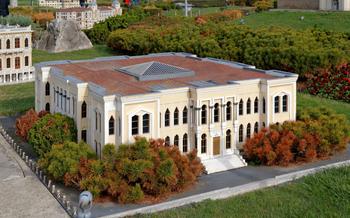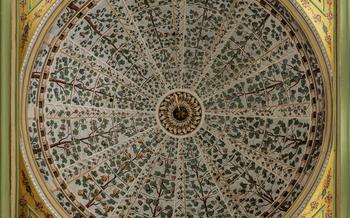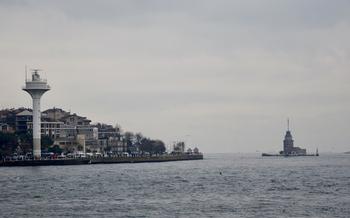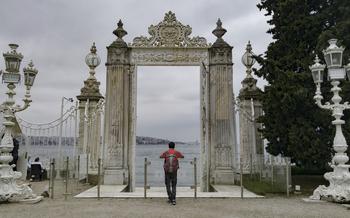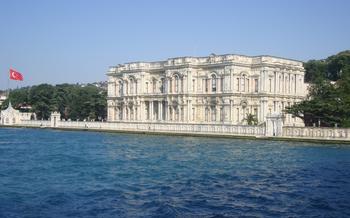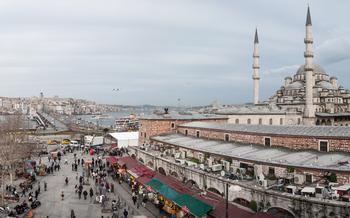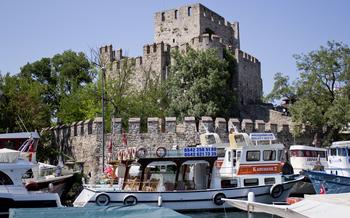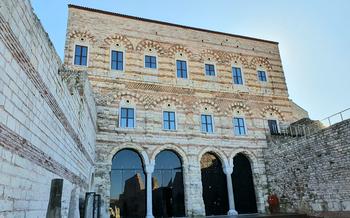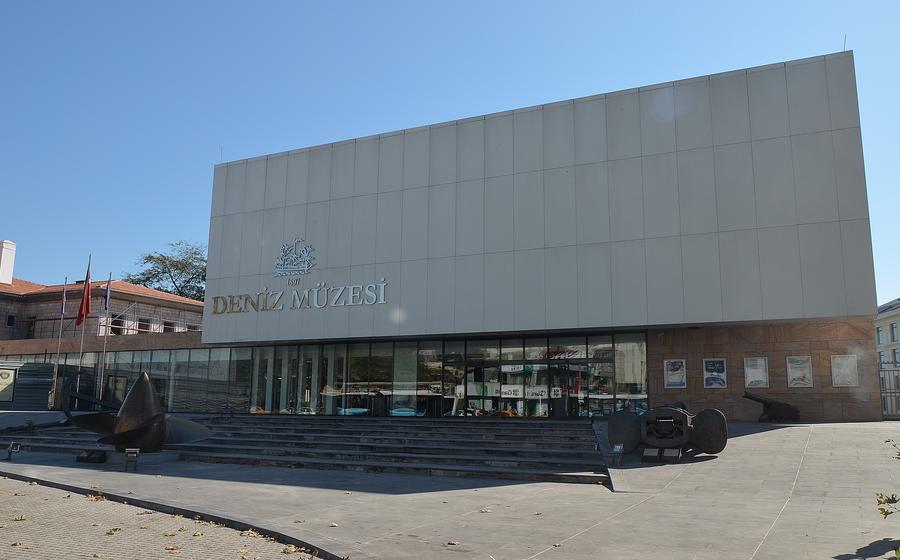
Naval Museum
- Historical Significance
- Location and Accessibility
- Hours of Operation and Admission Fees:
- Exhibits and Collections
- Historical Context
- Interactive Experiences
- Guided Tours
- Educational Programs
- Accessibility for Visitors with Disabilities
- Photography and Videography
- Food and Drink Options
- Nearby Attractions
- Dress Code and Etiquette
- Insider Tip:
Historical Significance
The Naval Museum in Istanbul stands as a testament to Turkey's rich maritime heritage, showcasing the evolution of the Turkish Navy from its humble beginnings to its current status as a formidable force. Established in 1897, this venerable institution has played a pivotal role in preserving and promoting the country's naval history.
The museum's exhibits narrate the captivating story of Turkey's maritime prowess, highlighting the pivotal role played by the navy in shaping the nation's destiny. From the grandeur of the Ottoman Empire, which ruled over vast seafaring territories, to the heroic struggle for independence during the Turkish War of Independence, the museum offers a comprehensive exploration of Turkey's naval legacy.
Moreover, the museum serves as a valuable educational resource, providing visitors with insights into the intricacies of naval warfare, shipbuilding techniques, and the remarkable achievements of Turkish seafarers throughout the ages. Through its extensive collection of artifacts, interactive displays, and informative panels, the Naval Museum stands as a beacon of knowledge and inspiration for all who seek to understand the profound impact of maritime history on the development of Turkey and the world.
Location and Accessibility
The Naval Museum is strategically located in the Beşiktaş district of Istanbul, offering easy access for visitors. Situated on the shores of the Bosphorus Strait, it is a short walk from the Beşiktaş Ferry Terminal and the Dolmabahçe Palace. Visitors can also reach the museum via public transportation, with several bus stops and metro stations nearby. The closest metro station is Beşiktaş, which is a mere 5-minute walk from the museum's entrance. For those arriving by car, limited parking is available in the vicinity. Additionally, the museum's proximity to other popular tourist destinations, such as the Dolmabahçe Palace, the Çırağan Palace, and the Ortaköy neighborhood, makes it an ideal starting point for a day of exploration in Istanbul.
Hours of Operation and Admission Fees:
The Naval Museum is open to the public from Tuesday to Sunday, with hours varying depending on the season. During the summer months (April to October), the museum is open from 9:00 AM to 6:00 PM, while in the winter months (November to March), it operates from 9:00 AM to 5:00 PM. It is closed on Mondays and on certain national holidays.
Admission fees are quite reasonable, with a standard ticket costing around 50 Turkish Lira (approximately 5 USD). Discounted rates are available for students, seniors, and military personnel. Guided tours are also offered at an additional cost, typically around 20 Turkish Lira (approximately 2 USD).
Visitors can purchase tickets at the museum's entrance. It is advisable to arrive early, especially during peak tourist season, to avoid long queues. The museum also offers online ticket booking for those who prefer to secure their entry in advance.
Exhibits and Collections
The Naval Museum boasts an impressive array of exhibits and collections that chronicle the rich maritime history of Turkey. Among its highlights is a collection of historic ships, including the TCG Heybeliada, a retired destroyer that served in the Turkish Navy for over 50 years. Visitors can step aboard this majestic vessel and explore its decks, cabins, and engine room, gaining a firsthand glimpse into the life of a sailor.
Other notable exhibits include a vast collection of naval artifacts, such as uniforms, weapons, navigation instruments, and ship models. These artifacts provide a tangible connection to the past, allowing visitors to appreciate the evolution of naval technology and the challenges faced by sailors throughout the centuries.
One of the most fascinating sections of the museum is dedicated to the Ottoman Navy. Here, visitors can learn about the rise and fall of one of the most powerful maritime empires in history. Interactive displays and detailed models bring to life the epic naval battles that shaped the course of history, including the Battle of Lepanto and the Siege of Vienna.
Temporary exhibitions and special events are also held regularly at the Naval Museum, offering visitors an opportunity to explore specific aspects of naval history in greater depth. These exhibitions often feature rare artifacts, guest speakers, and educational activities, providing a dynamic and engaging experience for visitors of all ages.
Historical Context
The Turkish Navy has a rich and storied history dating back to the Ottoman Empire, which ruled over a vast maritime empire for centuries. The museum showcases the evolution of the Turkish Navy from its early roots to its modern incarnation as a formidable force in the Mediterranean and beyond. Visitors can learn about the key role played by the navy in the Ottoman conquests, including the capture of Constantinople in 1453, which marked the beginning of the Ottoman Empire's rise to power. The museum also highlights the Turkish Navy's pivotal role in the Turkish War of Independence, where it played a crucial part in securing the country's independence from foreign occupation. Istanbul's strategic location at the crossroads of the Bosphorus and Dardanelles Straits has made it a vital naval base throughout history, and the museum sheds light on the significance of this strategic location in shaping the course of Turkish maritime history.
Interactive Experiences
The Naval Museum offers a range of interactive exhibits that bring history to life and enhance the visitor's understanding of naval warfare. Visitors can immerse themselves in the world of seafaring through virtual reality experiences that simulate sailing ancient warships or engaging in mock naval battles. Interactive displays allow visitors to explore the inner workings of ships, learn about navigation techniques, and test their skills in ship handling and damage control.
These interactive elements add a dynamic and engaging dimension to the museum experience, making it particularly appealing to younger visitors and those with a keen interest in naval history. Educational games and quizzes challenge visitors to test their knowledge and reinforce the lessons they have learned throughout their visit.
One particularly popular interactive exhibit is the ship simulator, which allows visitors to take the helm of a virtual warship and navigate through challenging waters. This immersive experience provides a unique perspective on the skills and challenges faced by naval commanders throughout history.
The Naval Museum's interactive exhibits not only entertain but also educate, fostering a deeper understanding of naval history and the contributions of the Turkish Navy to world maritime culture.
Guided Tours
The Naval Museum offers guided tours for visitors who want to delve deeper into the fascinating history of Turkey's naval heritage. These tours, led by knowledgeable and experienced guides, provide a unique opportunity to gain insights into the exhibits, learn about the historical context, and ask questions.
Guided tours are available in various languages, including English, Turkish, and other languages upon request. They typically last for about an hour and cover the museum's main highlights, including the historic ships, interactive displays, and artifacts. Visitors can book guided tours in advance through the museum's website or inquire about availability at the ticket counter.
I had the pleasure of experiencing a guided tour at the Naval Museum during my visit. Our guide, a retired naval officer with a passion for history, brought the exhibits to life with his captivating stories and detailed explanations. He shared insights into the significance of various artifacts, the challenges faced by the Turkish Navy throughout history, and the role of the museum in preserving the country's maritime heritage.
The guided tour greatly enhanced my understanding of the exhibits and provided a deeper appreciation for Turkey's rich naval history. Whether you're a history buff, a maritime enthusiast, or simply curious about the country's past, I highly recommend booking a guided tour at the Naval Museum.
Educational Programs
The Naval Museum is dedicated to promoting knowledge and understanding of Turkey's rich naval history. To this end, the museum offers a variety of educational programs and workshops designed to engage visitors of all ages, particularly children and school groups. These programs aim to foster a deeper appreciation for the significance of naval history and encourage an interest in maritime careers.
One of the most popular programs is the "Junior Mariners" workshop, which introduces young visitors to the basics of sailing and navigation. Through hands-on activities and interactive exhibits, children learn about the different parts of a ship, how to read a map, and the importance of teamwork in a maritime environment. The museum also offers workshops on model shipbuilding, where participants can build and decorate their own miniature ships using traditional techniques.
For school groups, the museum provides guided tours tailored to different age levels and educational needs. These tours cover a wide range of topics, from the history of the Turkish Navy to the science behind modern warships. Students can also participate in interactive quizzes and games that reinforce their learning and make the experience more enjoyable.
The Naval Museum's educational programs are a valuable resource for teachers and students alike. By providing engaging and interactive learning opportunities, the museum helps to cultivate a new generation of maritime enthusiasts and promotes a greater understanding of Turkey's naval heritage.
Accessibility for Visitors with Disabilities
The Naval Museum is committed to providing an inclusive and accessible experience for all visitors, including those with disabilities. The museum is fully wheelchair accessible, with ramps and elevators connecting all levels of the building. Designated parking spaces for visitors with disabilities are available in the museum's parking lot.
Assistive devices, such as wheelchairs and audio guides, are available for visitors with mobility or hearing impairments. The museum also offers sign language interpreters upon request, ensuring that visitors who are deaf or hard of hearing can fully enjoy the exhibits.
The museum staff is trained to assist visitors with disabilities and to answer any questions or concerns they may have. Visitors are encouraged to contact the museum in advance to inquire about specific accessibility needs or to arrange for special assistance.
Photography and Videography
The Naval Museum welcomes photography and videography for personal use, allowing visitors to capture their memories of the exhibits. However, certain guidelines must be followed to ensure the preservation and respect of the artifacts on display. Tripods and flash photography are generally not permitted within the museum to minimize any potential damage or disturbance to the delicate exhibits. Professional photography or videography for commercial purposes requires prior authorization from the museum administration.
When taking photos or videos, visitors are encouraged to be mindful of other visitors and avoid obstructing their views or disrupting their experience. Using natural light is recommended to capture the exhibits in their most authentic form, as artificial lighting may affect the colors and details of the artifacts.
The museum staff is always happy to assist visitors with any questions or concerns regarding photography and videography. By adhering to these guidelines, visitors can create lasting memories of their visit to the Naval Museum while respecting the historical significance and integrity of the exhibits.
Food and Drink Options
While the Naval Museum does not have its own café or restaurant, visitors can find a variety of food and drink options nearby. Just a short walk away, visitors will find several cafés and restaurants offering a range of cuisines, from traditional Turkish fare to international dishes. For a quick bite, there are also vending machines located within the museum, offering snacks and drinks.
For those looking for a more substantial meal, the surrounding area offers a plethora of culinary delights. From traditional Turkish kebabs to fresh seafood and international cuisine, there's something to satisfy every palate. Visitors can enjoy a leisurely lunch or dinner at one of the many restaurants in the nearby streets, many of which offer outdoor seating with stunning views of the Bosphorus Strait.
Whether you're looking for a quick snack or a memorable dining experience, the area surrounding the Naval Museum has something to offer. Take the opportunity to explore the local culinary scene and discover the diverse flavors that Istanbul has to offer.
Nearby Attractions
The Naval Museum is strategically located in the heart of Istanbul's historic district, surrounded by a wealth of other attractions that are easily accessible on foot or by public transportation. After immersing yourself in the world of naval history, take the opportunity to explore some of the city's other iconic landmarks and cultural treasures.
Just a short walk from the museum, you'll find the magnificent Hagia Sophia. This architectural masterpiece, once a cathedral and later a mosque, now serves as a museum and is renowned for its awe-inspiring dome and intricate mosaics. Delve into its rich history and admire the harmonious blend of Byzantine and Ottoman influences that make it a symbol of Istanbul's diverse heritage.
Another must-visit attraction nearby is the Topkapi Palace. This opulent former residence of Ottoman sultans offers a glimpse into the lavish lifestyle and political power of the empire. Wander through its sprawling courtyards, marvel at the exquisite tiles and intricate carvings, and soak in the ambiance of this once-powerful seat of government.
For those interested in art and culture, the Istanbul Modern Museum is a must-see. Located on the Bosphorus Strait, this contemporary art museum showcases a diverse collection of Turkish and international works, from paintings and sculptures to installations and video art. Admire the vibrant creativity of Turkish artists and gain insights into the country's modern cultural landscape.
These are just a few of the many attractions that await you within easy reach of the Naval Museum. Whether you're fascinated by history, architecture, art, or culture, Istanbul offers an endless array of experiences to enrich your journey.
Dress Code and Etiquette
When visiting the Naval Museum, it is essential to be mindful of the solemnity and historical significance of the exhibits. Visitors should dress respectfully, avoiding overly casual or revealing attire. Shorts, tank tops, and flip-flops are generally not considered appropriate.
It is important to maintain silence in certain areas of the museum, particularly near exhibits that commemorate fallen soldiers or depict sensitive historical events. Refrain from touching or leaning on the exhibits, as they are delicate and irreplaceable artifacts.
By adhering to these simple guidelines, visitors can demonstrate their respect for the museum's collection and create a conducive environment for all to enjoy and learn from the exhibits.
Insider Tip:
Unveil the Secrets of the Hidden Ship Model Room:
For a truly immersive experience, venture beyond the main exhibits and seek out the hidden treasure of the Naval Museum—the Ship Model Room. This secret chamber houses an extraordinary collection of meticulously crafted ship models, each representing a significant chapter in Turkish naval history. From ancient galleys to modern warships, these models offer a tangible glimpse into the evolution of Turkey's maritime prowess. Explore the intricate details of each vessel and uncover the stories behind their voyages, battles, and triumphs. This hidden gem is a must-visit for anyone seeking a deeper connection to Turkey's rich naval heritage.

